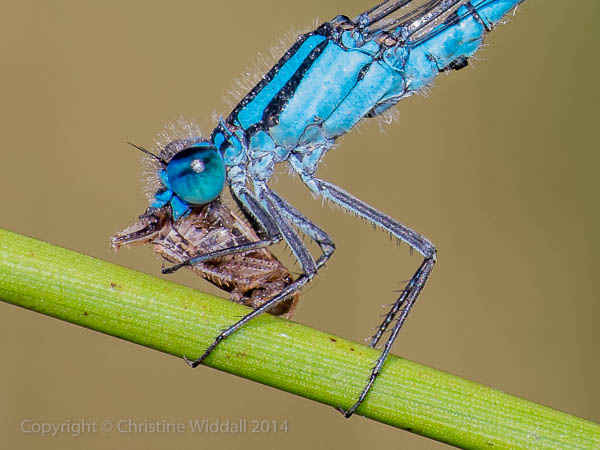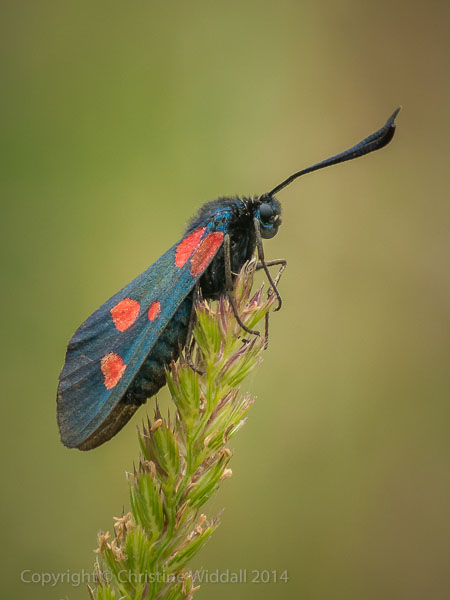Review of the Marumi DHG Achromat Macro 330 (+3) Close-up Lens
At the time of writing (July 2014), I have had the use of a Marumi Achromat Close-up 330 (+3) supplementary lens for about a month for photographing insects in the field and, with practice, my close ups of insects are improving.
Update 2020 – since writing the article
I am now also using a Canon camera with a Canon 100mm image stabilised macro lens and a 180mm sigma (non stabilised) macro lens, the latter of which I bought recently second-hand…because I am doing a lot more close up work. I stand by what I have written below and the results I can achieve with the Marumi are still usually undetectable from the macro lens results. I still carry the Marumi with me when not wanting to carry the extra weight of a macro lens, as it just slips into a pocket of my camera bag. It fits lenses from my Pentax or Canon cameras.
Marumi Achromat 330 (+3)
The following photograph was taken with a Pentax K5 IIs plus 50-135mm DA* zoom lens plus Marumi Achromat 330 (+3) supplementary lens screwed into the filter mount of the zoom lens. It was taken in the field, hand held and lit by sunlight on a bright but slightly hazy day at a country park in Lancashire.
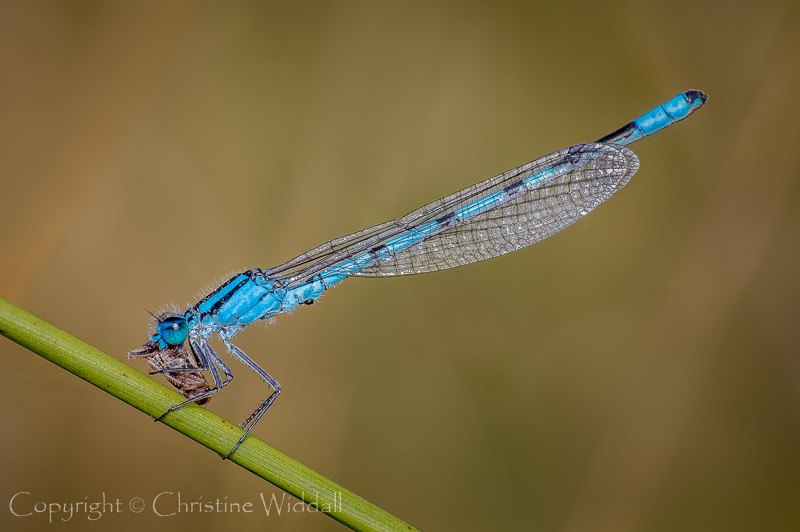
Below is a crop from the same photo.
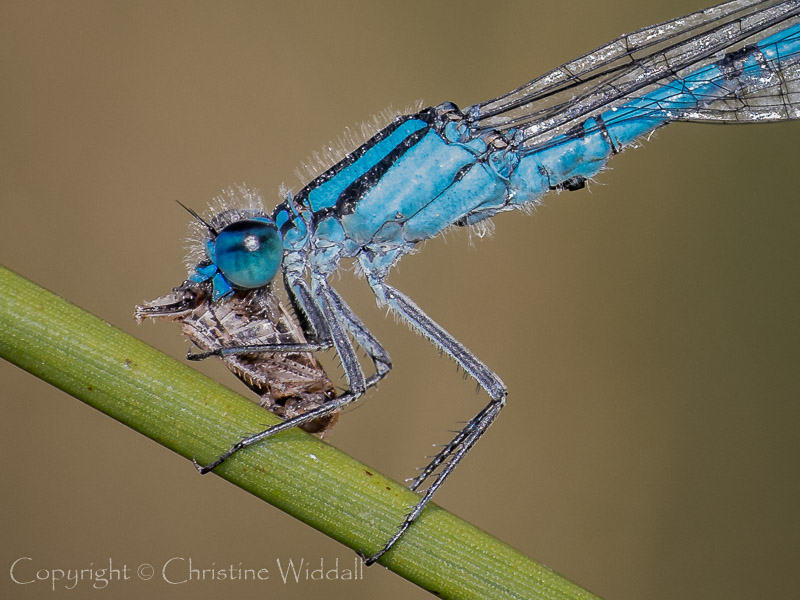
Why use a close up supplementary lens?
The crème de la crème for photographing close-up and macro subjects is, of course, a dedicated macro lens that will offer magnification up to 1:1 or better. I do possess a Pentax 35mm f/2.8 Limited Edition macro lens, which is tack sharp and photographs up to half life size (magnificaion 0.5x). In practice this is a great little lens for copying work, but the working distance is too close for insects, being just a couple of inches away from the subject at maximum magnification. Ideally, I needed to photograph insects from a greater working distance without having to go to the expense of buying a new macro lens. So, for now, I have a Marumi close-up attachment on loan from my father.
For anyone who wants to photograph small subjects just occasionally, the Marumi +3 attachment, complete with its own sturdy case, is only 25mm deep and will fit into a small space in the camera bag.
It is a cheap and effective way of taking macro photographs if you don’t have a dedicated macro lens.
About Marumi close-up lenses
I have always scorned the use of screw-in close up attachments since I used one in the past with very poor results. In fact there are still available plenty of sets of three close-up attachments (+1, +2, +4) from various manufacturers for about £20 for the set. These are of very variable quality and likely to produce inferior results including sharpness fall-off and chromatic aberrations (colour fringing problems).
However, achromatic lenses are designed to control the amount of chromatic and spherical aberration. Typically they are a close sandwich of two or three lenses with different properties that cancel out each others’ weaknesses. Consequently, the resulting image quality is much better than that of a simple lens…and, of course, they cost more. The Marumi DHG Achromat Macro 330 (+3) and DHG Achromat Macro 200 (+5) attachments are screw-in achromatic supplementary lenses which attach to the filter thread of a lens (prime or zoom) in the same way as any other filter attachment. They are an affordable way to convert a short telephoto lens to a macro lens and are available in filter thread sizes from 49mm to 77mm. Whilst the manufacturer’s recommended price ranges from about £100-£200 at the time of writing (depending on filter size), in practice they can be bought for about half of that price if you shop around.
I am currently using a 72mm Marumi +3 lens on the 67mm filter thread of my Pentax 50-135 DA* lens, with the aid of a 67-72 mm step-up ring. You would preferably buy the same size as your lens filter size or, if using it on more than one lens, buy the larger filter size and an appropriate step-up ring to use the attachment on the lens with the smaller filter thread. I would not recommend buying a size smaller than your lens’s filter size (to use with step-down rings) as it will almost certainly cause unwanted vignetting of your images.
Below are shots of my camera with step-up ring and close-up attachment fitted.

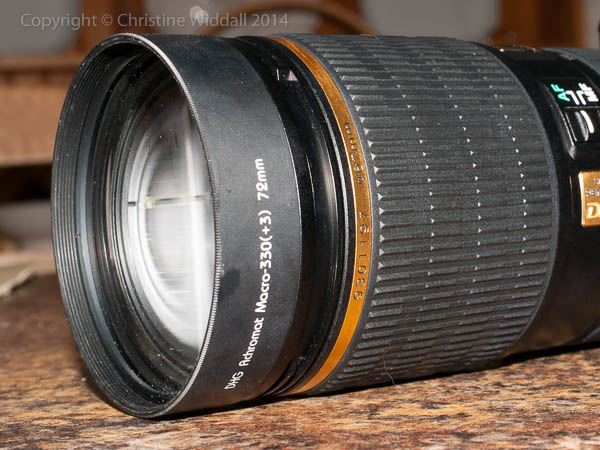
Technical Note
Depth of Field (DOF) is critical when using any close up lens or attachment. The only things that determine DOF for a given sensor size are the aperture chosen and the magnification of the subject at the film plane. Therefore, whether you use a macro lens, prime or zoom lens, extension tubes or close up attachment, you still only need to consider the aperture and magnification. If you want to know more about this and about diffraction limitation, there are links in my previous article, Photographing Insects in the Garden.
Subject Magnification
The magnification that you require will be determined by the subject matter that you are photographing. For insects, a magnification from about 1:5 (0.2x), for larger butterflies, up to 1:1 (life size) for small insects, such as ants, would be ideal. The way to calculate what magnification you will achieve with the close-up attachment is to take the focal length of your lens and divide it by the focal length of your close-up attachment.
Examples:
For a 200 mm lens and Marumi Achromat 330 (+3)…(the 330 in the name is the focal length in mm of the attachment)…take 200 and divide it by 330:
200/330=0.6, so that combination will give 0.6x magnification of the subject at the sensor (film) plane.
For a 135mm lens plus Marumi Achromat 330 (+3):
135/330=0.4, so that combination gives 0.4x magnification, just less than half life-size.
For 50mm lens and Marumi Achromat 330 (+3):
50/330=0.15 or the subject will be 15% of full size at the sensor plane.
The +5 attachment gives greater magnification throughout the range, but a closer working distance. With the +5 attachment and a 200 mm lens (the +5 attachment has a focal length of 200 mm), so:
200/200=1, so this gives a life size image. However, the working distance is very short, working with a life size image in the field is very difficult and depth of field problems make working at this magnification tricky in practice.
Using the lens/Marumi combination in practice
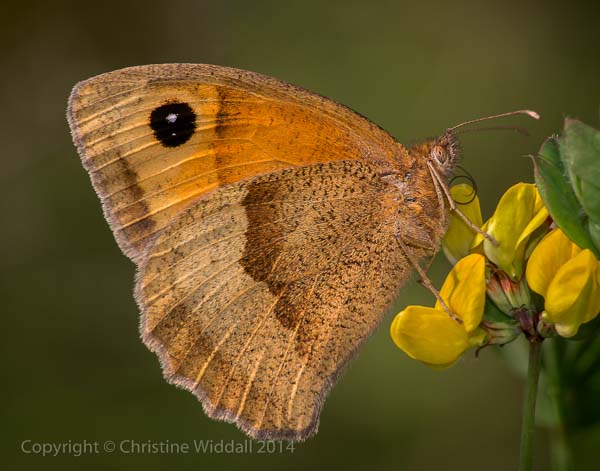
With my 50-135 zoom, I am using a crop frame camera with APS-C sensor and +3 supplementary lens. The close-up attachment gives a limited range in which focus on the subject can be achieved. It isn’t like using a macro lens, where focus can be achieved from infinity down to a few cm from the subject. It’s more like using extension tubes, so is more tricky in use than a macro lens.
First it is necessary to move to within focus range – this is easily found with experience. With the combination I am using, the focus distance is approaching 30cms from the end of the lens at the short end of the zoom range and a couple of cms less at the wide end of the zoom range. This does mean that it is necessary to approach the insects carefully and try not to create a shadow over them, which tends to make them fly off…but the working distance is generally quite comfortable.
The autofucus on my camera works quite well if within range otherwise it hunts horribly…as would be expected. An alternative method would be to focus the lens manually (set it to focus at infinity) then move in until the subject is sharp in the viewfinder…in years past, using a Tamron manual focus macro lens on a film camera, I used to set the focus in a similar way then move in on the subject.
Sharpness
This is not meant to be a learned article and is simply my observations of using the Marumi in practice. My impression, looking at my insect photographs, is that the quality is superb, but perhaps photographing a test chart will add some level of credibility to my opinion.
I wanted to look at sharpness fall-off across the frame, so I took a picture of a radial test chart. Below is the whole frame at the 50mm and the 135mm ends of the zoom lens, squashed down to 600 pixels wide (in each case, with the Marumi fitted). The chart was printed on ordinary office A4 paper on a laser printer, so quality is limited by that medium. However it shows no significant fall-off of sharpness across the frame at either end of the zoom range (generally it won’t be important to achieve tack sharpness at the frame corners as they will usually only contain background elements):

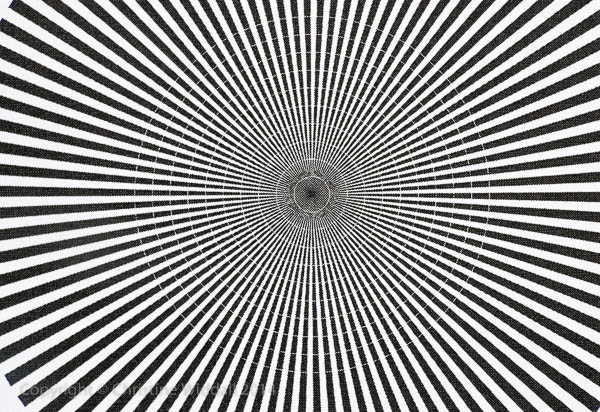
At the 135 end of the zoom range, I have also taken a 600 pixel crop out of the middle and edge of the frame:


Chromatic Aberration
I photographed a linear test chart, again printed on A4 office paper on an ordinary laser printer, to look for chromatic aberration on this particular lens/close-up attachment combination.
Here is the full width of the frame, squashed into 600 pixels wide for the web and a red-edged rectangular area which will be shown magnified below:
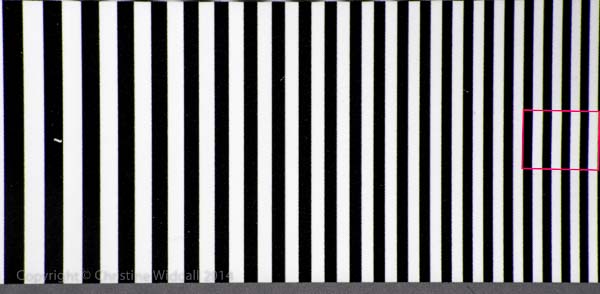
If I just take the last 600 pixels on the right hand side of the frame (shown with border in red above) and display it here at 100%, it can be seen that there is a small mount of chromatic aberration (blue/yellow fringing) at the edge of the frame. (As would be expected, there is no colour fringing at the centre of the image)

This is easily removed in Lightroom:

Conclusion
I was astonished at how good a supplementary lens could be. I am thoroughly enjoying the experience of photographing insects with the Marumi attachment and the results speak for themselves…very sharp images, good colour and contrast and only a little chromatic aberration, which is easily eliminated in post.
Typically, a 50-135 or 70-200 zoom lens with a Marumi +3 (330) close up attachment will be ideal for a variety of insects.
An advantage of using a supplementary lens over extension tubes, for example, is that it is not dependent on camera manufacturer or lens manufacturer…so long as you can match the filter size, it will fit any system and perform equally on any system. The qualities that it gives to the final image are the same with all camera/lens combinations but the overall quality of the image will also be dependent on the performance of the camera lens to which you attach it.
I would not hesitate in recommending a Marumi Achromat +3 close up attachment for anyone who just wants to try out close-up photography, is working to a budget or wants to add a lightweight attachment to their kit rather than carry around an additional extra lens. I was not disappointed.
Value for money (Below prices were correct on 28th May 2018)
- UK price of the Marumi DHG Acromat 330 @ 72 mm filter size (with free delivery from Amazon) costs £53.50. My husband just bought one!
- The 100mm Canon IS macro lens costs £900.00
- The Sigma 180mm f/3.5 macro lens costs £500.00
- The Sigma f/2.8 IS version of the Sigma 180mm lens costs £1,235.00
Conclusion
If you only want to do occasional macro – there’s no contest – Marumi all the way! If you do a lot of macro, a dedicated macro lens is ultimately the way to go. However, even if you buy a macro lens, there will always be times when you want to travel light and put that very tidy little Marumi lens in your pocket.
